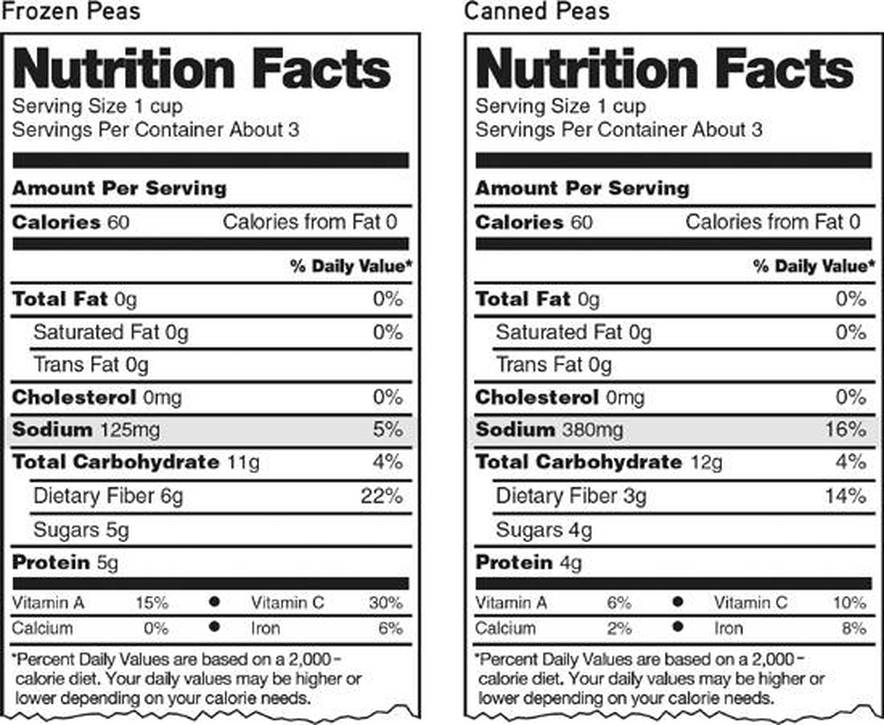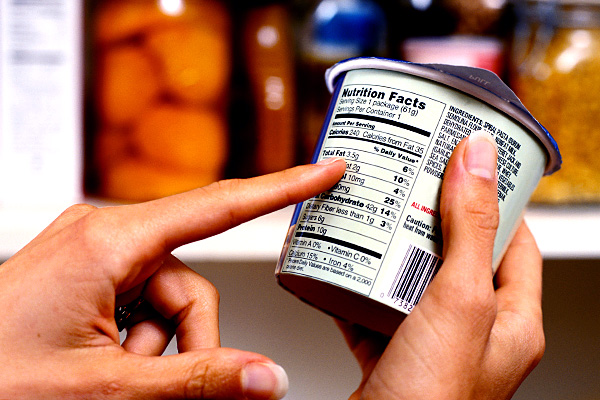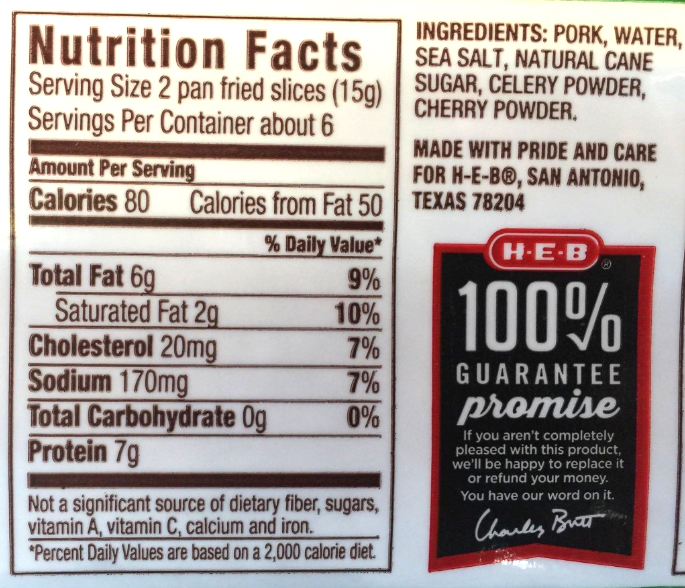43 reading sodium on food labels
Understanding food labels - Canada.ca Find information on food labels and how to understand them. Learn about nutrition facts tables, serving size, list of ingredients, % daily value and nutrition claims. ... Meaning of fat-free, no added sugar, low sodium, other nutrient content claims. Percent daily value. How to calculate % daily value on a nutrition facts table, how to use ... kidshealth.org › en › teensFood Labels (for Teens) - Nemours KidsHealth A food with 5% or less of a nutrient is low in that nutrient. A food with 10%–19% of a nutrient is a good source of that nutrient. A food with 20% or more of a nutrient is high in that nutrient. The information on food labels is based on an average adult diet of 2,000 calories per day.
› food › nutritionIs Sodium the Same Thing as Salt? - Eatright.org Aug 08, 2019 · On the label, look for foods that are lower in sodium. Choose foods with less than 120 milligrams of sodium per serving. Look for the words salt-free, sodium-free, very low sodium and low sodium on the label. Double-check sodium content of foods with labels that read unsalted, no salt added, reduced sodium or lower sodium.

Reading sodium on food labels
PDF Controlling Sodium and Reading Labels When You Shop As a general rule for sodium, 5% DV or less of sodium per serving is low whereas 20% DV or more of sodium per serving is high. Food labels will help you compare two choices so that you choose the lower sodium product. Lastly, be a smart shopper Look for "reduced-sodium" or "no-added salt" on the food label. Understanding Food Nutrition Labels | American Heart Association If you want to consume less of a nutrient (such as saturated fat or sodium), choose foods with a lower % DV (5 percent or less). If you want to consume more of a nutrient (such as fiber), choose foods with a higher % DV (20 percent or more). Here are more tips for getting as much health information as possible from the Nutrition Facts label: Your Guide to the New Food Label | National Kidney Foundation Food labels have percent daily values listed for a set group of nutrients based on the Food and Drug Administration (FDA) recommended 2000 calorie diet. ... Here is a list of ingredients to avoid when reading labels: chocolate and cocoa; ... look for foods with no more than 6 to 10% of the daily value for sodium. Keep an eye out for potassium ...
Reading sodium on food labels. Reading a Nutrition Label When You Have Diabetes and Kidney Disease If you have CKD, you may need to limit your sodium intake. Look for foods with less than 10 percent DV. Too much sodium can also raise your blood pressure and increase your risk of heart disease ... Understanding Ingredients on Food Labels - American Heart Association Mar 06, 2017 · Food labels are an important source of information about calories and the nutritional value of the. ... “Sodium nitrite is a source of salt in our diets,” Kris-Etherton said. “It’s in hot dogs, lunch meats and so on. ... Kris-Etherton said there’s no reason to complicate your label reading to this degree. A Guide to Reading Food Labels - University of Rochester Feb 27, 2013 · A Guide to Reading Food Labels Reading food labels can help you make wise food choices. Most foods list nutrition ... Americans typically eat too much saturated fat, trans fat, cholesterol, and sodium, which can increase the risk for heart disease, cancer or diabetes. Total fat is important to watch, but saturated fat and trans fat are How to Read Sodium Percentages on Food Packages - SF Gate A "very low sodium" product must have less than 35 milligrams of sodium, while a "low sodium" product must have less than 140 milligrams of sodium. All in the Name Along with reading the food...
Bulletin #4059, Sodium Content of Your Food - Cooperative … The amount of sodium in a serving of food is listed in milligrams (mg) and as a percent of the Daily Value on the nutrition label. ... Removing the saltshaker from the table is one good way to cut sodium intake. When reading labels for sodium content, look for “salt,” “sodium,” “monosodium glutamate,” and sodium added to words like ... How to Decode Salt on Food Labels: Low Sodium vs Reduced Sodium vs ... "Low sodium," "very low sodium," and "salt- or sodium-free" on food labels translate to less than 140, 35, and 5mg per serving, respectively. These front-of-the-package claims can help you spot legit lighter-sodium products at the supermarket—look for low sodium chicken broth, low sodium canned beans, low sodium bread, and low sodium soy sauce. How to Read a Food Label to Limit Sodium: Care Instructions On most foods, there is a Nutrition Facts label. This will tell you how much sodium is in one serving of food. Look at both the serving size and the sodium amount. The serving size is located at the top of the label, usually right under the "Nutrition Facts" title. The amount of sodium is given in the list under the title. › sites › defaulthow to understand food labels - Eat For Health Sodium (Salt) Choose lower sodium options among similar foods. Food with less than 400mg per 100g are good, and less than 120mg per 100g is best. Ingredients Listed from greatest to smallest by weight. Use this to check the first three ingredients for items high in saturated fat, sodium (salt) or added sugar. Other names for ingredients high in
Reading Labels - World Action on Salt & Health Some food labels may only state the sodium content. To convert sodium to salt, you need to multiply the amount by 2.5. For example, 1g of sodium per 100g = 2.5 grams of salt per 100g. You then need to know the weight of the serving portion in grams e.g. 30g. Then divide the concentration of salt per 100g by 100 and multiply by the serving size. How to Understand and Use the Nutrition Facts Label | FDA Nutrients to get less of: Saturated Fat, Sodium, and Added Sugars. Saturated fat, sodium, and added sugars are nutrients listed on the label that may be associated with adverse health effects - and... how to understand food labels - Eat For Health Sodium (Salt) Choose lower sodium options among similar foods. Food with less than 400mg per 100g are good, and less than 120mg per 100g is best. Ingredients Listed from greatest to smallest by weight. Use this to check the first three ingredients for items high in saturated fat, sodium (salt) or added sugar. Other names for ingredients high in What Sodium Labels Mean: A Guide to Decoding Sodium Labels On the back of a product, you'll find the nutrition label which will list the percentage daily value (or %DV) of sodium found in one serving. Be aware that the %DV is based on the upper recommended limit of daily sodium, or 2,400mg. Remember to Check the Serving Size
Reading Food Labels - What You Need to Know - Drugs.com The amount of sodium you should eat and drink each day should be less than 2400 mg. Most of the sodium people get in their diet comes from salt. Total Carbohydrate: The amount of carbohydrates in one serving is listed in grams. People with diabetes (deye-ah-BEE-teez) need to control the total amount of carbohydrates they eat.
How to Read Labels for a Low Sodium Diet - Salt Sanity Sodium nitrate is used to cure meats so you'll likely find it on labels of foods like lunch meat, bacon, and hot dogs. Research indicates sodium nitrate can damage arteries, causing them to harden and narrow, a potentially dangerous situation for patients with heart disease. There are some high sodium ingredients you will recognize.
› reading-food-labelsReading Food Labels | ADA - American Diabetes Association It’s time to decode those food claims. Trying to figure out nutritional information on labels and packaging isn’t easy. The good news is that we can help. Untangle packaging claims. If you get tripped up on food content claims, you’re not alone. Fat free vs. low fat vs. reduced fat. Low ...
PDF Reading Food Labels to Look for Sodium Easy-to-read food labels can help you find foods low in sodium. This will help you keep track of the number of grams (g) or milligrams (mg) you consume each day. According to Food and Drug Administration regula- tions, no manufacturer can say that their product is "low-sodium" unless they can prove that claim.
Reading food labels | Heart Foundation Reading food labels Nutrition information panels and ingredients lists are a good way of comparing similar foods so you can choose the healthiest option. Key takeaways. ... Sodium (salt) When you read the Nutrition Information Panel (NIP), it's important to remember that the salt content of the food product will be listed as 'sodium'. ...
Reading food labels: Tips if you have diabetes - Mayo Clinic Reading food labels: Tips if you have diabetes. Food labels can be an essential tool for diabetes meal planning. ... Nutrients and Daily Value: The label must list the amounts of total fat, saturated fat, trans fat, cholesterol, sodium, total carbohydrate, dietary fiber, sugars, protein, vitamin D, calcium, iron and potassium that are in one ...
How do you read a food label for salt / sodium? - Irish Kidney Diet If the salt content is not available on a label you can calculate it from the sodium content using the following: Sodium x 2.5 = salt content or Salt ÷ 2.5 = sodium content If you have kidney disease a good goal for sodium intake is 2300 mg of sodium or 6g salt per day.
How to Understand and Use the Nutrition Facts Label | FDA Feb 25, 2022 · Overview. The information in the main or top section (see #1-4) of the sample nutrition label (below) can vary with each food and beverage product; it contains product-specific information ...




Post a Comment for "43 reading sodium on food labels"